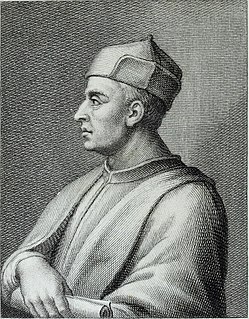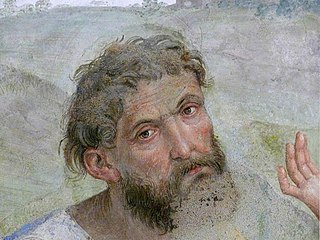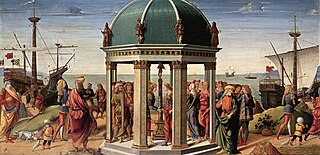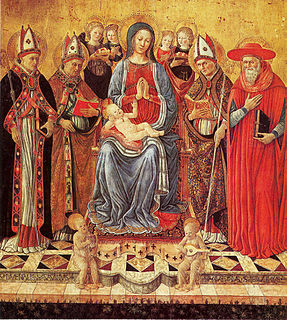

Dono Doni, also known as Adone Doni or Dono dei Doni (1505-1575) was an Italian painter of the Renaissance period active mainly in Umbria.


Dono Doni, also known as Adone Doni or Dono dei Doni (1505-1575) was an Italian painter of the Renaissance period active mainly in Umbria.
Doni was born at Assisi. While is said by Lanzi and others to have been a disciple of Pietro Perugino, [1] the first we know of him was that in 1530 he was an assistant to Giovanni di Pietro (lo Spagna) at San Giacomo in Spoleto. [2]
In the church of San Francesco, at Perugia, is a picture by this master of the 'Last Judgment;' and one of the 'Adoration of the Kings' is in San Pietro in the same city. There are in the Lower Church of the Franciscan Convent at Assisi frescoes by him representing the 'Preaching and Martyrdom of St. Stephen,' and in the small refectory is the 'Last Supper,' painted in 1573, which was probably his last work. Doni died at Assisi in 1575. Vasari is wrong in stating that he was a nephew of Taddeo Bartoli. In the Berlin Gallery there is by him a 'Madonna with the Infant Jesus,' who is represented as reaching after a book which is in the Virgin's hand.
He worked chiefly at Assisi. For the church of San Crispolto of Bettona, he painted an Adoration of the Shepherds (1543), now at the Pinacoteca Civica of the town. For the Ciccoli family chapel at the church of San Francesco in Bevagna, he painted a Madonna and Child (ca. 1565), now in the city picture gallery. In Foligno, he painted a fresco depicting the Nativity with St Lucy (1544) for the monastery of Sant' Anna, a frieze for the Sala Papale of Palazzo Trinci (attributed, ca. 1545), a fresco depicting the Martyrdom of St Catherine of Alexandria for the nunnery of Santa Caterina Vecchia, now detached and in the Pinacoteca Civica. In Gubbio, he painted a Pietà (after 1560) and a Road to Calvary (ca. 1564) now in the Duomo. [3] He also worked with Lattanzio Pagani and Cristofano Gherardi at the no longer-extant Rocca Paolina of Perugia.

Luca Signorelli was an Italian Renaissance painter who was noted in particular for his ability as a draftsman and his use of foreshortening. His massive frescoes of the Last Judgment (1499–1503) in Orvieto Cathedral are considered his masterpiece.

Pinturicchio, or Pintoricchio, also known as Benetto di Biagio or Sordicchio, was an Italian painter during the Renaissance. He acquired his nickname because of his small stature and he used it to sign some of his artworks that were created during the fifteenth and sixteenth centuries.

Benedetto Bonfigli was an Italian Renaissance painter born in Perugia, and part of the Umbria school of painters including Raphael and Perugino. He is also known as Buonfiglio. Influenced by the style of Domenico Veneziano, Benozzo Gozzoli, and Fra Angelico, Bonfigli primarily painted frescos for the church and was at one point employed in the Vatican. His best preserved work is the Annunication, but his masterpiece is the decoration of the chapel of the Palazzo dei Priori. Bonfigli specialized in gonfaloni, a Perugian style using banners painted on canvas or linen. Little is known of his personal life, but he was an esteemed painter in Perugia before Perugino, who is said to be his pupil.

Pietro Perugino, born Pietro Vannucci, was an Italian Renaissance painter of the Umbrian school, who developed some of the qualities that found classic expression in the High Renaissance. Raphael was his most famous pupil.

Benozzo Gozzoli was an Italian Renaissance painter from Florence. A pupil of Fra Angelico, Gozzoli is best known for a series of murals in the Magi Chapel of the Palazzo Medici-Riccardi, depicting festive, vibrant processions with fine attention to detail and a pronounced International Gothic influence. The chapel's fresco cycle reveals a new Renaissance interest in nature with its realistic depiction of landscapes and vivid human portraits. Gozzoli is considered one of the most prolific fresco painters of his generation. While he was mainly active in Tuscany, he also worked in Umbria and Rome.

Lo Spagna, "the Spaniard" in Italian, was a painter of the High Renaissance, active in central Italy. His name was Giovanni di Pietro, but he was known as Lo Spagna because he was born in Spain. After Raphael, he was a main pupil and follower of the Umbrian painter Perugino, whose style his paintings develop. He should not be confused with Pietro di Giovanni D'Ambrogio of Siena.
Pier Antonio Mezzastris was an Italian painter of the Quattrocento, painting in a somewhat provincial style for the time.

Spello is an ancient town and comune (township) of Italy, in the province of Perugia in east central Umbria, on the lower southern flank of Mt. Subasio. It is 6 km (4 mi) NNW of Foligno and 10 km (6 mi) SSE of Assisi.

The Basilica of Saint Francis of Assisi is the mother church of the Roman Catholic Order of Friars Minor Conventual in Assisi, a town in the Umbria region in central Italy, where Saint Francis was born and died. It is a Papal minor basilica and one of the most important places of Christian pilgrimage in Italy. With its accompanying friary, Sacro Convento, the basilica is a distinctive landmark to those approaching Assisi. It has been a UNESCO World Heritage Site since 2000.

Bettona is an ancient town and comune of Italy, in the province of Perugia in central Umbria at the northern edge of the Colli Martani range. It is 5 km (3 mi) E of Torgiano and 12 km (7 mi) SW of Assisi.

Giuseppe Maria Crespi, nicknamed Lo Spagnuolo, was an Italian late Baroque painter of the Bolognese School. His eclectic output includes religious paintings and portraits, but he is now most famous for his genre paintings.

The basilica diSan Pietro is a Catholic basilica and abbey in the Italian city of Perugia.

Federico Bencovich was a prominent late Baroque painter from Dalmatia working in Italy. He is best known as Federico Bencovich or Federigo or Federighetto or Dalmatino. In modern Croatia he is known as Federiko Benković.

Antonio d'Enrico, called Tanzio da Varallo, or simply il Tanzio was an Italian painter of the late-Mannerist or early Baroque period.

Biagio d’Antonio Tucci was an Italian Renaissance painter active in Florence, Faenza and Rome.

Giovanni Boccati or Giovanni di Pier Matteo Boccati was an Italian painter.

Ottaviano Nelli (1375–1444?) was an Italian painter of the early Quattrocento. Nelli primarily painted frescoes, but also panel paintings. He had several pupils and two painters were influenced by him.
Giacinto Boccanera (1666-1746) was an Italian painter.
Jacopo Siculo, also known as Giacomo Santoro da Giuliana (1490-1544) was an Italian painter of the Renaissance, mainly active in Umbria.

Anton or Antonio Maria Fabrizi or Fabrizzi was an Italian painter, active in Perugia and Foligno in a Baroque style.
| Wikimedia Commons has media related to Dono Doni . |
Attribution: